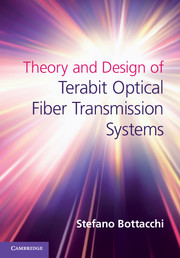Book contents
- Frontmatter
- Dedication
- Contents
- Preface
- Acknowledgments
- Part I Signals, spectra and optical modulations
- Part II Principles of light polarization and optical amplification
- Part III Interferometric optical modulators
- 8 Theory of the single-mode optical coupler
- 9 Theory and applications of the Mach–Zehnder interferometer
- 10 Interferometric optical responses
- 11 Chirp theory of the Mach–Zehnder modulator
- 12 Theory and modeling of the quadrature Mach–Zehnder modulator
- Part IV
- Appendix A Electromagnetic energy and power flow
- Appendix B Optical power and photon flux
- Index
- References
9 - Theory and applications of the Mach–Zehnder interferometer
Enabling high-order optical modulation and smart interferometric devices
from Part III - Interferometric optical modulators
Published online by Cambridge University Press: 05 September 2014
- Frontmatter
- Dedication
- Contents
- Preface
- Acknowledgments
- Part I Signals, spectra and optical modulations
- Part II Principles of light polarization and optical amplification
- Part III Interferometric optical modulators
- 8 Theory of the single-mode optical coupler
- 9 Theory and applications of the Mach–Zehnder interferometer
- 10 Interferometric optical responses
- 11 Chirp theory of the Mach–Zehnder modulator
- 12 Theory and modeling of the quadrature Mach–Zehnder modulator
- Part IV
- Appendix A Electromagnetic energy and power flow
- Appendix B Optical power and photon flux
- Index
- References
Summary
Introduction
This chapter deals with the theory of the continuous-wave (CW) operation of the optical Mach–Zehnder interferometer (MZI). We will approach the interferometric effect and the formation of signal interference at the output ports using the phasor technique, assuming a monochromatic optical field. The analysis of the MZI excited by a generic (modulated) optical field, using the Fourier transform technique, will be presented in Chapter 10.
Section 9.2 illustrates the operating principle of the MZI, assuming reader familiarity with the transfer characteristic of the ideal single-mode optical coupler. Section 9.3 presents the phasor transfer matrix as the most general mathematical tool for representing the linear relationships between input and output ports of the MZI. Using the phasor transfer matrix it is easy to write a general expression for the output phasors in terms of the CW fields applied to the input ports, leading to interesting examples and applications. Sections 9.4 and 9.5 analyze the asymmetric and symmetric topologies, respectively, and provide further examples and simulations. Section 9.6 introduces operation of the MZI as a linear optical phase modulator, including mathematical modeling and simulations. Section 9.7 presents the optical amplitude modulation feature of the MZI.
- Type
- Chapter
- Information
- Theory and Design of Terabit Optical Fiber Transmission Systems , pp. 663 - 761Publisher: Cambridge University PressPrint publication year: 2014
References
- 1
- Cited by



